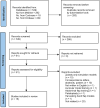Simulation models for learning local skin flap design and execution: A systematic review of the literature
- PMID: 35937603
- PMCID: PMC9346067
- DOI: 10.3389/fsurg.2022.918912
Simulation models for learning local skin flap design and execution: A systematic review of the literature
Abstract
Introduction: Early exposure to practical skills in surgical training is essential in order to master technically demanding procedures such as the design and execution of local skin flaps. Changes in working patterns, increasing subspecializations, centralization of surgical services, and the publication of surgeon-specific outcomes have all made hands-on-training in a clinical environment increasingly difficult to achieve for the junior surgeon. This has been further compounded by the COVID-19 pandemic. This necessitates alternative methods of surgical skills training. To date, there are no standardized or ideal simulation models for local skin flap teaching.
Aim: This systematic review aims to summarize and evaluate local skin flap simulation and teaching models published in the literature.
Materials and methods: A systematic review protocol was developed and undertaken in accordance with PRISMA guidelines. Key search terms encompassed both "local skin flaps" and "models" or "surgical simulation". These were combined using Boolean logic and used to search Embase, Medline, and the Cochrane Library. Studies were collected and screened according to the inclusion criteria. The final included articles were graded for their level of evidence and recommendation based on a modified educational Oxford Center for evidence-based medicine classification system and assessed according to the CRe-DEPTH tool for articles describing training interventions in healthcare professionals.
Results: A total of 549 articles were identified, resulting in the inclusion of 16 full-text papers. Four articles used 3D simulators for local flap teaching and training, while two articles described computer simulation as an alternative method for local flap practicing. Four models were silicone based, while gelatin, Allevyn dressings, foam rubber, and ethylene-vinyl acetate-based local flap simulators were also described. Animal models such as pigs head, porcine skin, chicken leg, and rat, as well as a training model based on fresh human skin excised from body-contouring procedures, were described. Each simulation and teaching method was assessed by a group of candidates via a questionnaire or evaluation survey grading system. Most of the studies were graded as level of evidence 3 or 4.
Conclusion: Many methods of simulation for the design and execution of local skin flaps have been described. However, most of these have been assessed only in small cohort numbers, and, therefore, larger candidate sizes and a standardized method for assessment are required. Moreover, some proposed simulators, although promising, are in a very preliminary stage of development. Further development and evaluation of promising high-fidelity models is required in order to improve training in such a complex area of surgery.
Keywords: local flap design; local flaps; plastic surgery training; simulation models; teaching; training.
© 2022 Hadjikyriacou, Goldsmith, Bowerman, Dobbs and Whitaker.
Conflict of interest statement
The authors declare that the research was conducted in the absence of any commercial or financial relationships that could be construed as a potential conflict of interest.
Figures
Similar articles
-
Advancing Surgical Education: A Comprehensive Systematic Review with Meta-Analysis and Novel Approach to Training Models for Local Skin Advancement Flaps.Cureus. 2023 Jul 18;15(7):e42066. doi: 10.7759/cureus.42066. eCollection 2023 Jul. Cureus. 2023. PMID: 37602042 Free PMC article. Review.
-
Beyond the black stump: rapid reviews of health research issues affecting regional, rural and remote Australia.Med J Aust. 2020 Dec;213 Suppl 11:S3-S32.e1. doi: 10.5694/mja2.50881. Med J Aust. 2020. PMID: 33314144
-
A Training Model for Local Flaps Using Fresh Human Skin Excised During Body Contouring Procedures.J Surg Res. 2021 Jun;262:190-196. doi: 10.1016/j.jss.2021.01.011. Epub 2021 Feb 16. J Surg Res. 2021. PMID: 33607413
-
Animal models in plastic and reconstructive surgery simulation-a review.J Surg Res. 2018 Jan;221:232-245. doi: 10.1016/j.jss.2017.08.052. Epub 2017 Sep 28. J Surg Res. 2018. PMID: 29229134 Review.
-
The effectiveness of internet-based e-learning on clinician behavior and patient outcomes: a systematic review protocol.JBI Database System Rev Implement Rep. 2015 Jan;13(1):52-64. doi: 10.11124/jbisrir-2015-1919. JBI Database System Rev Implement Rep. 2015. PMID: 26447007
Cited by
-
Overview of surgical training and assessment of surgical skills: a narrative review.Front Surg. 2025 Jun 25;12:1605495. doi: 10.3389/fsurg.2025.1605495. eCollection 2025. Front Surg. 2025. PMID: 40636914 Free PMC article. Review.
-
Advancing Surgical Education: A Comprehensive Systematic Review with Meta-Analysis and Novel Approach to Training Models for Local Skin Advancement Flaps.Cureus. 2023 Jul 18;15(7):e42066. doi: 10.7759/cureus.42066. eCollection 2023 Jul. Cureus. 2023. PMID: 37602042 Free PMC article. Review.
References
Publication types
LinkOut - more resources
Full Text Sources



